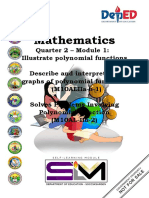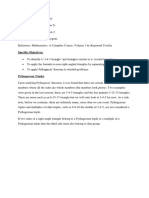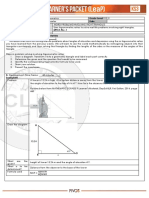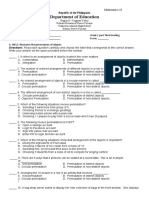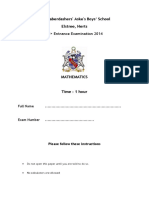MATHEMATICS10-QUARTER2-WEEK5
1
Department of Education National Capital Region Schools Division of Parañaque City Self-Learning Modules
Mathematics 10 Quarter 2 Week 5 TANGENTS AND SECANTS OF CIRCLES Learning Competency
The learner illustrates secants, tangents, segments, and sectors of a circle. (M10GE-lle-1)
Objective
The learner illustrates secants, tangents, segments, and sector of a circle.
Let’s Recall
Identify the following.
1. A segment with endpoints on a circle. 2. A segment from the center to a point on a circle. 3. A chord that passes through the center of a circle. 4. An arc less than a semicircle. 5. An angle with vertex at the center of a circle.
Let’s Understand
In circle P,
̅
is a chord line BD is a secant line EB is a tangent
●
B is the point of tangency REMEMBER: A secant is a line that intersects the circle at two distinct points. It contains a chord. A tangent is a line that intersects the circle at exactly one point called the point of tangency. Sector and Segment of a Circle
•
A sector of a circle is the region bounded by an arc of the circle and two radii to the endpoints of the arc. To find the area of a sector of a circle, get the product of the ratio
ℎ
and the area of the circle.
Area of a Sector = (
) (
r
2
)
where a = measure of the arc Example: The radius of circle C is 12 cm. If m AB =60, what is the area of sector ACB? Solution: Area of a Sector = (
) (
)(12)
2
Area of a Sector = (
) (
) (144) cm
2
Area of a sector = 24
cm
2
or Area of a Sector = 24(3.14) cm
2
Area of a Sector = 75.36 cm
2
•
A segment of a Circle is the region bounded by an arc and the segment joining its endpoints. In the figure, the shaded region is the segment of circle T. It is the region bounded by PQ and PT. To find the area of the shaded segment in the figure, subtract the area of
∆
PTQ from the area of sector PTQ.
T P
A C B E D

MATHEMATICS10-QUARTER2-WEEK5
2
Example: If m PQ = 90 and the radius of the circle is 5 cm. Find the area of the shaded region. Area of Sector PTQ = (
) (5) cm
2
Area of Sector PTQ =
25
cm
2
•
Arc Length can be determined by using the proportion (
) = (
2
) Example: An arc of a circle measures 45°. If the radius of the circle is 6cm, what is the length of the arc? Solution: (
) = (
2
) (
) =
2
=
2
= 4.71 cm
5
=
2()
8
= 12
=
2(.)
Let’s Apply
A. Use the figure to name and identify the following.
1. a diameter 6. 2 points of tangency 2. 4 radii 7. 2 central angle 3. a chord 8. an inscribed angle 4. a secant 9. 2 minor arcs 5. 2 tangent line 10. the center of the circle
Let’s Analyze
A. The radius of the circle at the right is 10cm. Find the length of each of the following arcs given the degree measure.
1. m PV = 45, length of PV = _______________ 2. m PQ = 60, length of PQ = _______________ 3. m QR = 30, length of QR =_______________
B. Refer to the diagram on the right in naming the following.
1. Two circles 2. Two secants 3. A tangent common to both circles 4. A chord of the smaller circle 5. A diameter of a smaller circle 6. A tangent only to smaller circle 7. A secant to the smaller circle 8. Two chords of bigger circle 9. A point of tangency of both circles 10. Two congruent triangles
Let’s Evaluate
A. Illustrate and label the following in the given circle. Make your illustration neat and clean.
1. point O, the center of the circle 6. tangent line AD 2. radius OB 7. point of tangency A 3. diameter AB 8. central angle COB 4. chord AC 9. inscribed angle CAB 5. secant line EB 10. semicircle ACB
B. The radius of a circle given is 9cm. Find the length of each of the following arcs given the degree measure.
1. m RTS = 120; length of RTS =________ 2. m QRT=90; length of QRT=________
D
P
A B C E
O A S
R T W U P Q R S V
T
In the same figure, the area of
∆
PTQ =
2
(25) cm
2
Area of the shaded region =
(
25
) (3.14) -
252
cm
2
Area of the shaded region = 19.63
–
12.5 = 7.13 cm
2
MATHEMATICS10-QUARTER2-WEEK5
3
PROVING THEOREMS RELATED to SECANTS, TANGENTS and SEGMENTS
Learning Competency
The learner proves theorems related to secants, tangents and segments. (M10GE-lle-f-1)
Objective
The learner proves and applies theorems in secants, tangents and segments.
Let
’
s Recall
Use the figure at the right. Tell whether each of the following statements is TRUE or FALSE.
1. Point S is a point on a circle 2. CD contains chord CD 3. SB is congruent to SC 4. line AB is a secant 5. arc BEC is a semicircle 6. line AC is a tangent 7.
∠
BAC is a central angle 8. Line DC intersects the circle at two points 9. Point A is a point of tangency 10. ED is twice SD
Let
’
s Understand
REMEMBER: Tangent to a Circle
•
A line in the plane of the circle that intersects the circle at exactly one point is called tangent line. The point of intersection is called the point of tangency. Theorems on Secants, Tangents and Segments A. Theorems on Tangent Lines 1. Tangent Line Theorem: If a line is tangent to a circle, then it is perpendicular to the radius at its outer endpoint. Example:
⃡
is tangent circle O at B. If
̅
= 6cm and
̅
= 8 cm, how far is point A from the center? Solution: Applying the Pythagorean Theorem AO =
√
2
+
2
AO =
√ 100
AO =
√ 6
2
+8
2
AO = 10 cm AO =
√ 36+64
•
Connecting the center pt. O to pt. A forming a right triangle, then
̅
⊥
⃡
2. Tangent
–
Segment Theorem: If two tangent segments are drawn to a circle from an external point then, a. the two tangent segments are congruent and b. the angles between the tangent segments and the line joining the external point to the center of the circle are congruent. Given:
̅
and
̅
are tangent segments to circle C. Prove: a. OT
≅
OU b.
∠
TOC
≅∠
UOC Proof: Statements Reasons 1.
̅
and
̅
are tangent segments to circle C 1. Given 2.
̅
⊥
̅
and
̅
⊥
̅
2. Tangent Line Theorem 3.
∠
OTC and
∠
OUC are right angles 3. Definition of perpendicularity 4.
∆
OTC and
∆
OUC 4. Definition of a right triangle 5.
̅
≅ ̅
5. Radii in a circle are congruent 6. Draw
̅
6. The Line Postulate
O
B A T O
C U
D E A B C
S
MATHEMATICS10-QUARTER2-WEEK5
4
7.
̅
≅ ̅
7. Reflexive Property 8.
∆
OTC
≅
∆
OUC 8. Hy-L Theorem 9.
̅
≅ ̅
9. CPCTC 10.
∠
TOC
≅
∠
UOC 10. CPCTC B. Theorems on Angles Formed by Tangents and Segments
1. Inscribed Angle Theorem
: The measure of an angle formed by a tangent and a secant drawn at the point of contact is one-half the measure of its intercepted arc. Given: circle O with
⃡
as tangent and intersecting secant
⃡
at point B. Prove: m
∠
ABC =
2
m AB Proof was given on the previous lesson.
2. Intersecting Secants
–
Exterior Theorem
•
The mea
sure of an angle formed by two secants that intersect in the exterior of a circle is one-half the difference of its intercepted arcs. Given: circle O with secants
and
Prove: m
∠
A =
2
(m BC
–
m DE) Proof: By construction connect B and E. In
∆
BEA,
∠
3 is an exterior angle. We can say that
∠
3 =
∠
2 +
∠
A and
∠
A =
∠
3 -
∠
2.
∠
3 =
2
m BC and
∠
2 =
2
m DE (Inscribed Angle Theorem) By substitution,
∠
A =
∠
3 -
∠
2 =
2
m BC -
2
m DE. Therefore, m
∠
A =
2
m(BC
–
DE)
3. Intersecting Secants
–
Interior Theorem
•
The measure of an angle formed by two secants intersecting in the interior of the circle is equal to one
–
half the sum of the measures of its intercepted arcs. Given:
⃡
intersects
⃡
at P. Prove: m
∠
DPB =
2
(m BD + m AC) Proof: Statements Reasons 1.
⃡
intersects
⃡
at P 1. Given 2. Draw
2. The Line Postulate 3. m
∠
DPB = m
∠
DAB + m
∠
ADC 3. The Exterior Angle Theorem 4. m
∠
DAB =
2
m BD 4. The Inscribed Angle Theorem 5. m
∠
ADC =
2
m AC 5. The Inscribed Angle Theorem 6. m
∠
DAB + m
∠
ADC =
2
m BD +
2
m AC 6. Addition Property of Equality 7. m
∠
DAB + m
∠
ADC =
2
(m BD + m AC) 7. Distributive Property of Equality 8. m
∠
DPB =
2
(m BD + m AC) 8. Transitive Property of Equality C. Power Theorems 1. The Intersecting Segments of Chord Power Theorem (Two Chord Power Theorem)
•
If two chords intersect in the interior of the circle, then the product of the lengths of the segments of one chord is equal to the product of the lengths of the segments of the other chord. Given: chords AB and CD intersect at K
Prove: AK ● BK = CK ● DK
Proof: Statements Reasons 1. AB and CD intersect at K 1. Given
C
O
A B D E A
P
B C D A
K
B C D A
O
B C D












